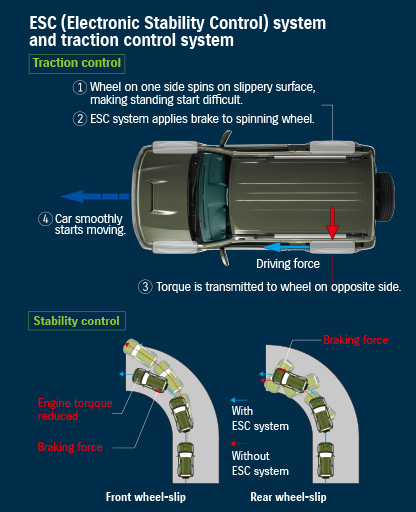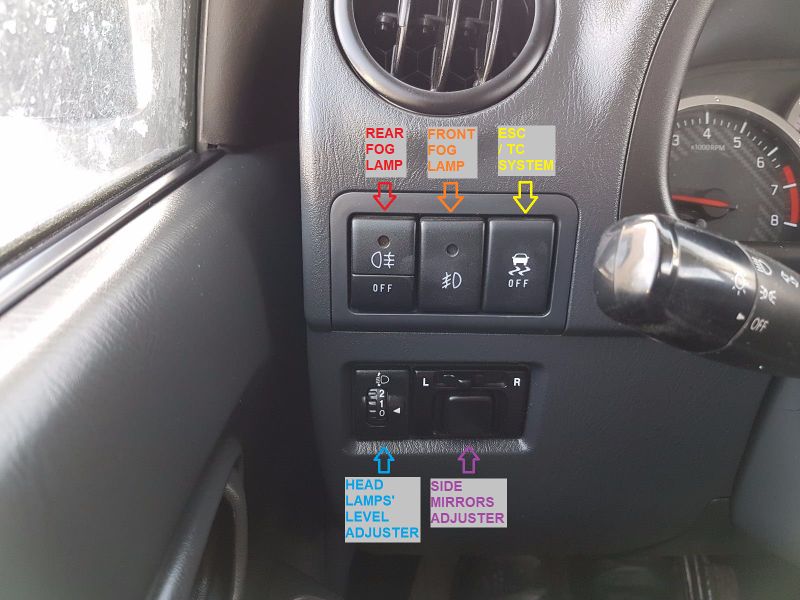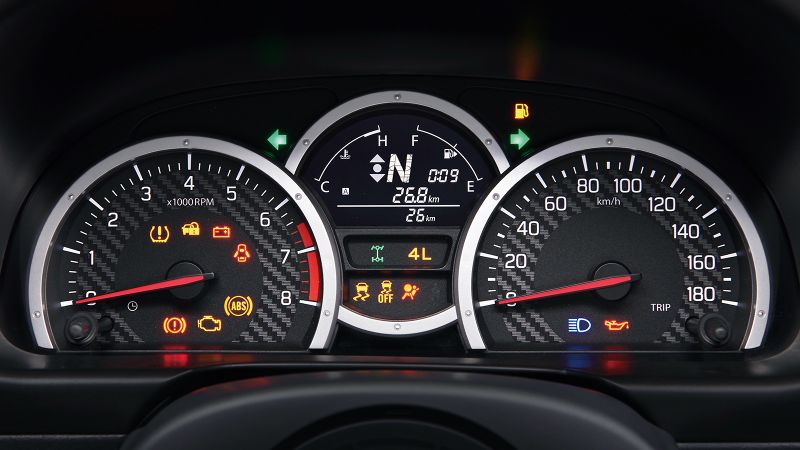![]() The content of any article might be expanded / improved in the future - revisit it sometimes.
The content of any article might be expanded / improved in the future - revisit it sometimes.
![]() Seen a mistake? Know something that isn't written? Edit and change this article yourself!
Seen a mistake? Know something that isn't written? Edit and change this article yourself!
![]() Some images in the article (if present) can be enlarged by clicking on them.
Some images in the article (if present) can be enlarged by clicking on them.
Contents
Introduction
- Suzuki added Electronic Stability Control (ESC) and Traction Control (TC) systems in Jimny 3 somewhere in the period 2013-2015 (depending on the market).
- Since then, ESC and TC systems for Jimny 3 have been optional in some markets, while they are mandatory in others.
![]() More about the history of revisions to the Jimny vehicle model can be found in the Generic world Wikipedia article on Jimnys.
More about the history of revisions to the Jimny vehicle model can be found in the Generic world Wikipedia article on Jimnys.
- The typical mystery and confusion about ESC and TC in Jimnys is how and when they exactly work, with the primary question being whether they have any usefulness in all-terrain driving situations.
- The purpose of this article is to clarify those mysteries and confusions (to the best knowledge of this forum's users).
Official documents
- This is official Suzuki's leaflet which describes the operation of Jimny 3's ESC and TC systems in a brief summary.
- The leaflet confirms that there are actually two systems - electronic stability control (ESC) system and traction control (TC) system.
- What is not properly explained here is that the ESC and TC in Jimny 3 are two functionally separate systems.
- More on that will be explained below.
Switches and indicator lamps
- Jimnys 3, which have ESC (and TC) installed, also have a dedicated switch in the cabin to control the operation of those systems.
- Let's call it an "ESC/TC switch" for the sake of simplicity.
- It is the right-most switch in the three-switch cluster (above the external mirrors adjustment switch), together with the fog lamp control switches.
- The ESC/TC switch has a symbol of a skidding vehicle (with the "OFF" letters beneath) imprinted on it.
- The ESC/TC switch provides the driver with the ability to manually turn ESC to ON or to OFF state.
- The ESC/TC switch can also turn TC to ON or to OFF state - read more in one of the chapters below!
- This is a "return" type switch.
- That means that the switch automatically returns to its default position immediately after the pressure on it has been released.
- In other words, this switch never stays pressed in after being pressed.
- Therefore, the state of ESC or TC is not judged by the physical position of this switch, but by the indicator lamp(s) on the instrument panel.
- All Jimnys 3 which have ESC (and TC) should also have the latest (3rd edition) instrument panel, like the one on this picture.
- This is a picture of such instrument panel from a Jimny 3 sold in continental Europe, with all the indicator lamps turned on.
- Notice the two yellow indicator symbols and one orange symbol at the bottom of the center circle.
- The left yellow indicator symbol (a skidding vehicle) is inactive 99% of the time.
- It will just blink intermittently (sporadically) only when the ESC or the TC system "kicks in" in real time during a predicament (when vehicle starts to skid on road or when it loses traction off road).
- This means that this indicator light is shared by the two systems.
- The center yellow indicator symbol (a skidding vehicle with "OFF" letters below it) indicates exclusively whether ESC is ON or OFF.
- This symbol does not indicate the operational status of the TC system.
- Whenever ESC is ON, this symbol will be OFF (will be unlit / inactive).
- This symbol will be constantly lit during the entire time while the vehicle is in 4WD-L mode, and all the time while the ESC is manually turned OFF by the driver in 2WD-H or 4WD-H modes.
- This is additionally explained further below.
Operation of the ESC and TC systems
General principle
- The programming is such that Jimny 3's ESC system works only in 2WD-H and 4WD-H transmission modes, and the TC system works only in 4WD-L transmission mode.
- Therefore, only one (or none) of those systems can be active at a certain point in time, but not both at once.
- Both systems share the same operation indicator lamp on the instrument panel.
- It is the leftmost bottom yellow symbol in the center section, as shown in the picture above.
ESC domain
- The ESC system in a Jimny 3 works as a typical vehicle stability control system.
- This means that ESC monitors if the vehicle has started to skid or to spin out (on a bend for example).
- If that happens, ESC attempts to correct vehicle's trajectory by swiftly manipulating each individual wheel brake, engine throttle, etc.
- This means that ESC monitors if the vehicle has started to skid or to spin out (on a bend for example).
- ESC is not effective in situations when vehicle has lost momentum due to the loss of traction on one or more wheels, and needs to continue further from that point.
- This is a typical off-road predicament.
Switching ESC between ON and OFF states
- ESC can be turned OFF or ON manually by the driver in 2WD-H and 4WD-H transmission modes simply by pressing the ESC/TC button.
- ESC's operational status will be indicated by the corresponding lamp on the instrument panel.
- A typical reason why someone might want ESC to be OFF is to enjoy some sporty spirited driving (in a Jimny !?).
- ESC can not be turned ON in 4WD-L transmission mode.
TC domain
- When the vehicle shifts into 4WD-L mode, the ESC system automatically turns OFF and the TC system automatically turns ON.
- In 4WD-L mode, the TC system will monitor if any wheel is staring to spin.
- If that happens, TC will selectively and intermittently apply the brake on the spinning wheel.
- Its goal is to fool the axle differentials to "hand over" the torque to the other wheel on that axle, which presumably has more traction than the useless wheel.
- This is very similar in concept to the traction control systems found in many other 4WD vehicle models (Land Rover Discovery 2 for example).
- This in practice means that Jimny 3's TC system can significantly aid the driver off-road on some slippery terrain and especially in cross-axle off-road situations.
- When the vehicle returns from 4WD-L transmission mode back into 4WD-H or 2WD-H mode, TC will automatically turn OFF and ESC will automatically turn ON.
Situations where TC is undesirable
- The operation of the TC system in 4WD-L mode can be a disadvantage in certain all-terrain driving situations.
- Example is when charging up a slippery hill (for example: a very loose gravel incline or a muddy incline).
- In this case, when all four wheels are furiously spinning and spraying gravel or mud all around, the TC system will start selectively and intermittently breaking all of them.
- This will "steal" vehicle's momentum and lead it to a standstill on the middle of the ascent, or even to an engine stall.
- It's almost like charging up a hill and then simultaneously applying both the brakes and the throttle in the middle of the critical struggle during the ascent - like shooting yourself in the foot.
- This will "steal" vehicle's momentum and lead it to a standstill on the middle of the ascent, or even to an engine stall.
- In this case, when all four wheels are furiously spinning and spraying gravel or mud all around, the TC system will start selectively and intermittently breaking all of them.
Watch this video from time point 2:55 onward to see a situation where traction control actually hinders the momentum and thus progress (example is on a Jimny 4, but it could have been any other all-terrain vehicle with traction control for that matter).
Switching TC between ON and OFF states
- TC can be turned OFF or ON manually by the driver in 4WD-L transmission mode by long pressing the ESC/TC button.
- Long pressing means holding the button pressed in for at least a couple of seconds.
- Unfortunately, the vehicle will give no sound nor audio indication that the TC has just been switched ON or OFF.
- The only way to check if TC is ON or OFF in 4WD-L mode is to field-test it by applying strong sudden throttle in 1st low or 2nd low gear on a slippery surface.
- When TC is ON, the operational indicator lamp on the instrument panel will blink intermittently as the vehicle is struggling for traction during acceleration.
- When TC is OFF, that indicator lamp will not blink and the vehicle will have a classic behavior.
This field-test video portrays and proves the above statements (video starts with vehicle in 4WD-L mode and TC ON):
Professional tests and reviews
Review from Australian Practical Motoring magazine
- Read this professional Australian off-road test drive review of a Jimny 3 with ESC/TC.
- The review focuses specifically on the ESC/TC systems in late production Jimny 3, and evaluates the operation of the systems in all terrain conditions.
Test on rollers in Poland
Here is a Polish video which vividly portrays the operation of Jimny 3's ESC and TC systems in a controlled environment:
- The test on rollers simulates the loss of traction in off-road conditions.
- It clearly shows the ineffectiveness of the ESC system in 4WD-H mode, and the effectiveness of the TC system in 4WD-L mode.
Comparative test on rollers in Poland - Jimny 3 vs 4
Here is a Polish video which portrays a good comparison of Jimny 3's and 4's ESC and TC systems in a controlled environment:
Conclusions
To summarize, here are several key points.
- Jimnys 3, which have ESC, have in fact two separate systems - ESC and TC.
- ESC works only in 2WD-H and 4WD-H mode.
- It is ON by default, but it can be turned OFF by the driver.
- ESC is useful on-road, but rather useless off-road.
- In 2WD-H and 4WD-H modes, the ESC system is useful to prevent vehicle from skidding or spinning out during relatively high velocities on bends etc.
- ESC turns OFF automatically (if it has not already been turned OFF by the driver) when 4WD-L transmission mode is engaged.
- TC works only in 4WD-L transmission mode.
- TC can be manually turned OFF / ON while the vehicle is in that mode, by long pressing the ESC/TC button (for at least a couple of seconds).
- TC works relatively effectively to aid vehicle's traction in cross-axle off-road situations and in some slippery conditions.
- However, TC can be a hindrance in certain slippery situations.
- Both ESC and TC share the same operational indicator lamp on the instrument panel.
- Both ESC and TC are probably operated by the same dedicated controlling computer.
- The computer probably just has two different operational / programming modes (one for ESC and one for TC).
- Therefore, ESC and TC are two functionally and logically separate systems (they are separate from the operational and driver's point of view).
- Both systems share (more or less) the same hardware and electronics - it's just the operational logic that differs them.
- Therefore, ESC and TC are two functionally and logically separate systems (they are separate from the operational and driver's point of view).
Special note
- Don't forget that all these are unofficial conclusions based on inputs from various forum members and from a few Internet sources.
- It could easily be possible that the programming of Jimny 3's ESC/TC controller differs for different world markets!
- Only Suzuki could officially clarify all this!
Page last edited on 17/06/2019 by user Bosanek



